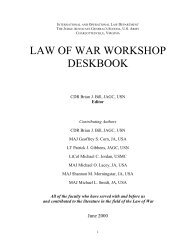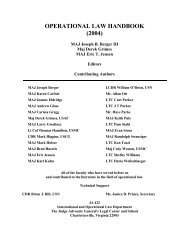Warning Analysis for the Information Age - Higgins Counterterrorism ...
Warning Analysis for the Information Age - Higgins Counterterrorism ...
Warning Analysis for the Information Age - Higgins Counterterrorism ...
You also want an ePaper? Increase the reach of your titles
YUMPU automatically turns print PDFs into web optimized ePapers that Google loves.
ways can be identified in this way so that every new MDA of a differentWMD or CBRNE program will become easier as a common WMDMDA model is built <strong>for</strong> each type of WMD and a range of differentstrategies within that model emerges by analysis of multiple programs.Biologists now exploit <strong>the</strong> power of homology searching by using a few simplebioin<strong>for</strong>matics tools to deduce <strong>the</strong> function and mechanisms of newly discoveredgenes by comparison with evidence in DNA, protein, genetic, and o<strong>the</strong>rdatabases—without having to per<strong>for</strong>m any additional laboratory or field experiments!Once MDA has been used to profile a few WMD programs, using similarhomology searching methods can recall more evidence from <strong>the</strong> current databaseswithout having to per<strong>for</strong>m new field collection. If analysts concentrate onusing systematic MDA-assisted hypo<strong>the</strong>sis testing to build better <strong>the</strong>ories andassessments against a worldwide baseline of WMD programs, not only will ourunderstanding of individual programs greatly improve, but an understanding ofWMD proliferation mechanisms will inevitably emerge.Computers Don’t Think, People Think—New Thinking Tools<strong>for</strong> <strong>the</strong> In<strong>for</strong>mation <strong>Age</strong>A system is defined as a set of different elements so connected orrelated as to per<strong>for</strong>m a unique function not per<strong>for</strong>mable by <strong>the</strong> elementsalone. 61 Annette KrygielSystems, like <strong>the</strong>ir biological counterparts, are defined by what <strong>the</strong>y DO, notwhat <strong>the</strong>y ARE. The “database problem” is not a problem with databases at all.Ra<strong>the</strong>r, <strong>the</strong> problem is to build a new system of people and in<strong>for</strong>mation technology(IT) systems by which <strong>the</strong> analysts can, in fact, find Novel Intelligence inMassive Data and can, in fact, provide strategic warning. The new system will becomposed of people and computers whereby <strong>the</strong> computers and <strong>the</strong> databases<strong>the</strong>y contain will be tools <strong>for</strong> <strong>the</strong> analysts to use to become smarter.The problem with <strong>the</strong> “database” problem is in first realizing that <strong>the</strong>re are atleast four different kinds of databases. Each corresponds to <strong>the</strong> datasets thatresearchers already use in hypo<strong>the</strong>sis testing (data repository, data collection, evidencefile, and assessment outline) and each is distinct in its <strong>for</strong>mat and usage.And it is very important to keep clear <strong>the</strong> distinction between databases and <strong>the</strong>datasets <strong>the</strong>y contain. Lessons learned from MDA projects on WMD programs61 Krygiel, 32.140
















